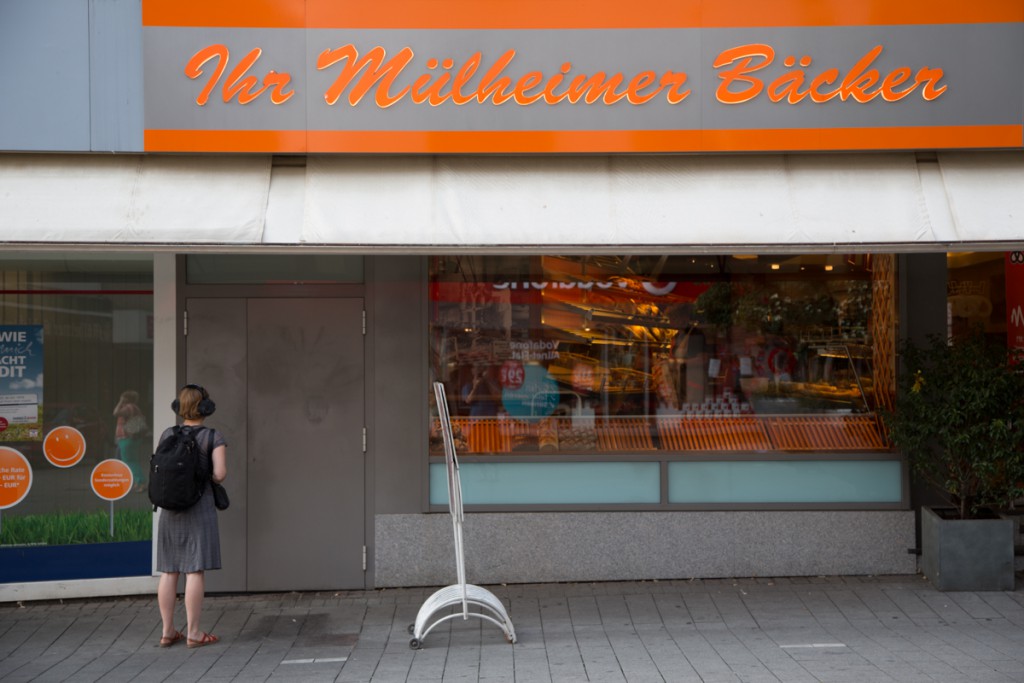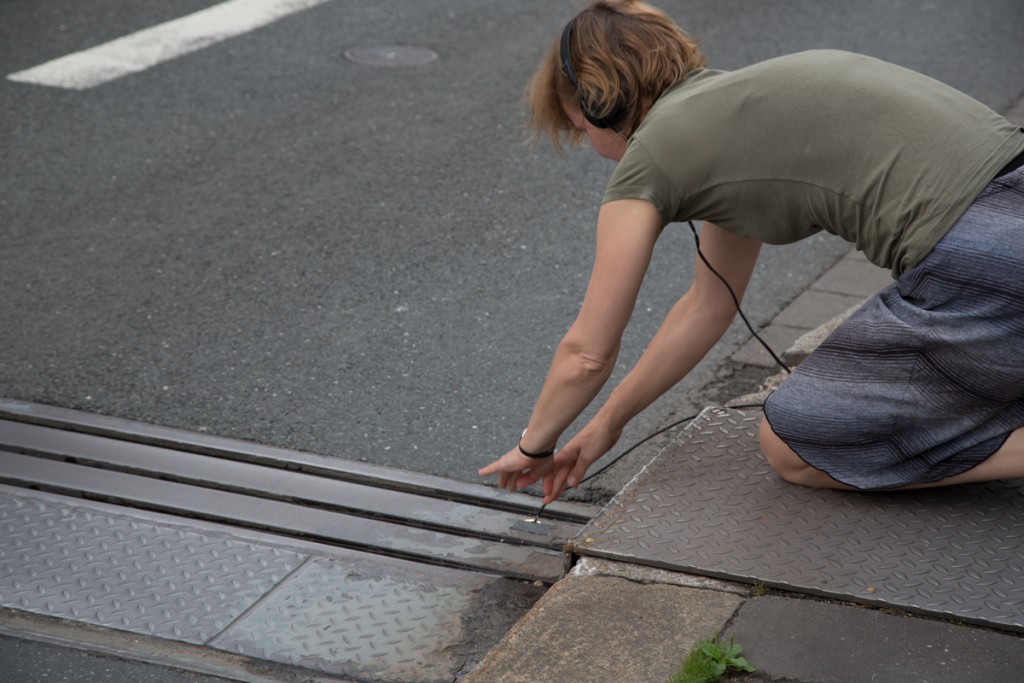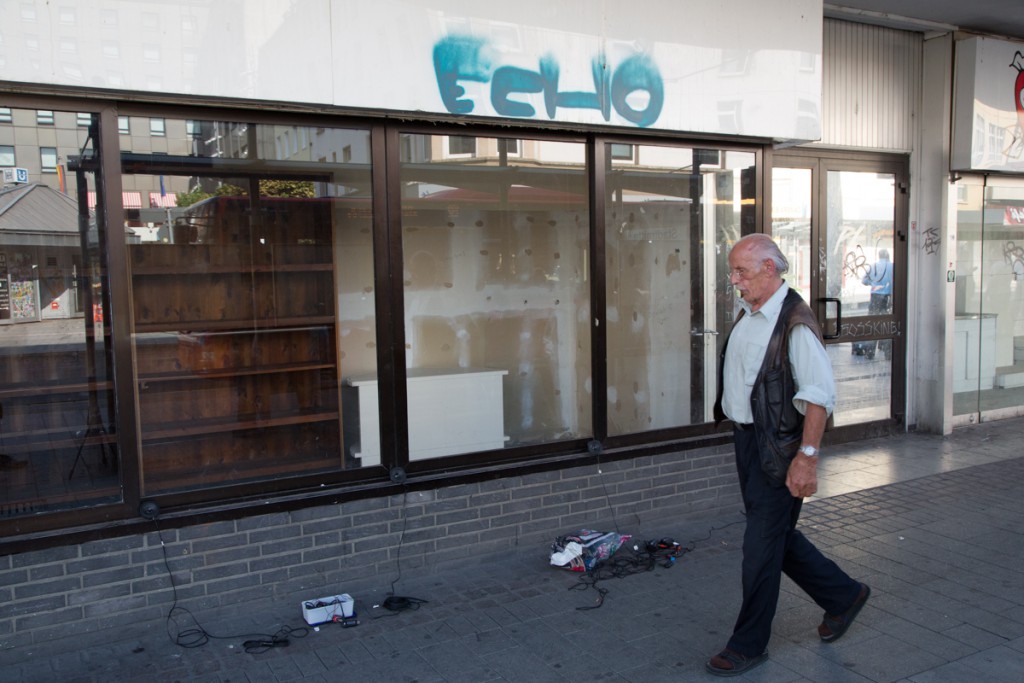by Kirsten Reese
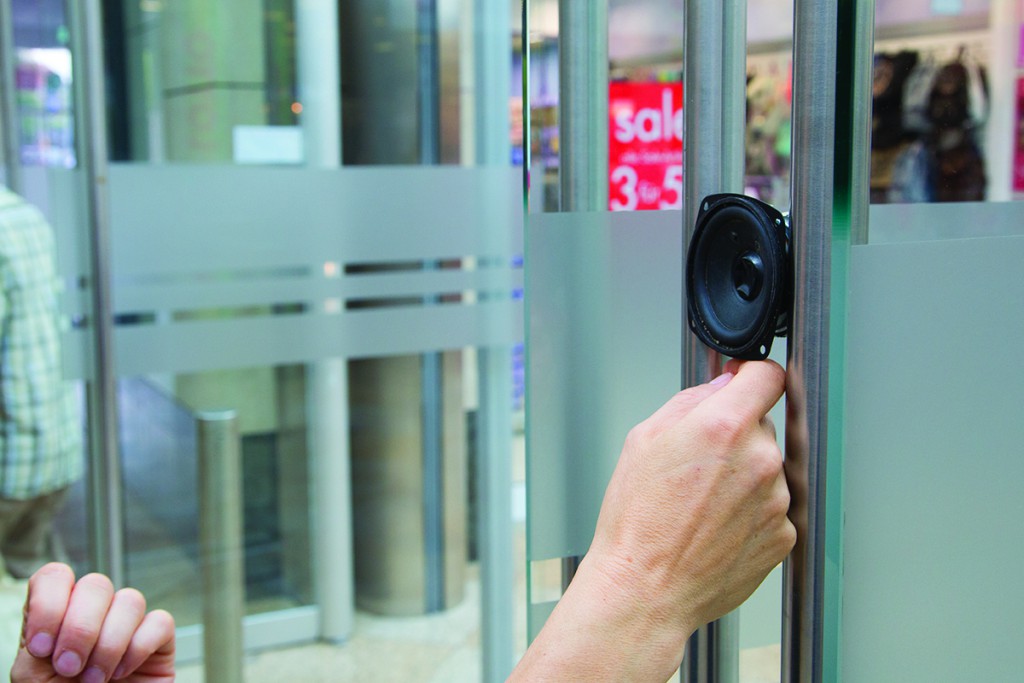
Photo 01: Exploring the passageway between the railway station and the Forum shopping mall.
Down into the subway.
Exploration and ‘Findings’: the Mülheim–Logbook
Each day of the five-day fieldwork in Mülheim was structured in a similar manner, with three components: explorations in the city – observing, listening, and recording; reacting to our observations by creating a small-scale sound work in the work space; and installing this sound work at a specific space in the city, feeding back our experiences.This recurring structure stood for an experimental, but at the same time systematic approach, leading us not to judge the interim results but instead to focus on the process. In the mornings we walked around the city, exploring a new area each day. While walking, we talked, sharing and comparing our observations in these field explorations and discussing experiences with and evaluations of earlier works. In some places we made recordings – what struck our interest could be quite varied. The third part of the fieldwork involved installing small-scale interventions with two to four loudspeakers at chosen sites, through which could be heard recorded material from the site or sound material referring to the site in some way. The installations used the following equipment: 2–4 loudspeaker chassis with a diameter of 8 cm, mobile amplifiers, mp3-players; the installations were stereo or 4-channel. I had already used this equipment in several other installations in open spaces; for this reason, they were a good reference point for the experiments in Mülheim.
Day 1, Monday 22 July
Field exploration
1. Pedestrian zone Mülheim, Schloßstraße and surrounding streets.
Recordings
1. Subway escalator: the sound of this escalator is striking, because it is very specific. Following R. Murrary Schafer (weblink), it could be termed a ‘hidden’ soundmark of Mülheim – ‘hidden’ because it is probably not noticed consciously by many people. Notably, the escalators in other subway shafts in Mülheim, such as Schloß Broich station, sound very similar.
Audio 01: Escalator at Mitte subway station, Mülheim.
2. Drone from ventilation outside a bakery in Schloßstraße: we called this drone the ‘Neuhaus drone’, because it reminded us of a Max Neuhaus installation: a chord (an impure fifth with fluctuating overtones), soft, barely noticeable at first, but once you had focused your listening on it, it would stick in the brain.
Photo 02 & Audio 02: ‘Neuhaus drone’ from ventilation outside bakery.
3. Recording in the space between the Forum shopping mall (since the early 1990s these malls have sprung up everywhere in inner cities in Germany; the Centro in nearby Oberhausen is a huge, famous shopping mall in the Ruhrgebiet that has had a long term effect on the situation of smaller shops and on shopping possibilities, and on the attractiveness and liveliness of Mülheim’s central district).

Photo 03: Passageway between the railway station and the Forum shopping mall.
In Hoert auf diese Stadt!, an audio walk through the city of Magdeburg produced in 2013 in cooperation with Theater Magdeburg, one listening station was
situated in the biggest local shopping mall, Allee Center. Like an inner voice, one hears the names of chain stores that one can see when standing at a particular position, company names typical of all these malls, and there is a discussion (between the characters in the audio piece) about public and private space and the functions that these shopping malls have today: are they the agora of today’s cities? Coincidentally, after having discussed these questions in preparation for the audio walk, we found out that the neo-Nazi party the NPD had recently used this exact location on their ‘action day’ to distribute leaflets against European politics. (weblink)
The Forum mall adjoins the (also privately owned) railway station building, and thus blocks the direct transition through the inner city – the route between the train station and the main pedestrian zone, the Schloßstraße.
4. Piezo recording inside a photo booth at the railway station: as expected, we were questioned by security guys, who informed us that making recordings, taking pictures, or filming videos in this space was not allowed without permission.

Photo 04: Working in the photobooth in the hall of the public transports.
Intervention/installation
1. Placement of speakers in front of the bakery, playing the original drone recording with added synthesised sound matching the pitches of the ventilation drone.
Effect/observation: The installation was too soft – although the original drone at the site was also low in volume, it sounded much richer; the synthesised tones did not match the pitches/harmony of the drone.
Day 2, Tuesday 23 July
Field exploration
Along the back way from our flat through the Eppinghofen immigrant district, under the railroad bridge crossing the busy Tourainer Ring, and over the Helmut Schlitt pedestrian bridge to the Forum, along Schloßstraße again.
Recordings
1. Under the railroad bridge: although one hears the traffic of the busy road under the bridge, and trains passing above, one also hears footsteps of a person walking alone – to me an impression of relative silence, representing the ‘backside of the city’.
Audio 03: Under the railroad bridge, the ‘backside of the city’.
2. Further recordings: ATM Machine, ventilation shaft, Schloßstraße fountains, pharmacy, road sweeper, newsagents.
3. Another long recording under the railroad bridge in the afternoon, this time with strong thunderstorms and rain.
Video 01: Under the railroad bridge, beginning to rain and thunder. (Surround audio recording, best listened to through headphones.
4. In the evening on the way home, a recording under the other railroad bridge, in the ‘silent’ pedestrian underpass, after the storm.
Audio 04: Later that night, under another railroad bridge/pedestrian underway.
Intervention/installation
1. Installation on the pedestrian bridge named after Helmut Schlitt, a jazz musician who started a jazz scene in Mülheim in the 1950s. A four-speaker installation with Helmut Schlitt playing trumpet, banjo jazz/oldtime jazz.
Effect/impressions: The sound for the intervention consisted of samples of original jazz music, overlaid on the four channels. Playing the music from small speakers in an outside space embedded in a soundscape with lots of traffic noise decontextualised it, which made the music appear like abstracted sound material, like a ‘sound object’ in itself, rather than a piece of music with it’s own integrity.
The installation led to a long conversation with a passer-by, who had approached us and asked what we were doing. When we explained, he asked us if we were jazz fans. He was about eighty years old, a retired architect, who had apparently led an exciting, active professional career with many ups and downs. After he was forced to give up his company he had moved to Mülheim. He was well dressed, although in a conservative but slightly dated style, as if he had once been better off – but he showed a cheerful, optimistic attitude throughout the conversation.

Photo 05: Preparing an intervention on the pedestrian bridge.
2. Because of the heavy rainfall in the afternoon, we did not realise the plan to place an intervention under a graffiti reading ‘Pussy Riot’ on a wall at Tourainer Ring with sound from the Pussy Riot cathedral performance in Moscow. This would have been another reinstallment of unedited, musical material related to the space in a more abstracted way (name of pedestrian bridge – jazz scene in Mülheim and the Ruhrgebiet in the 1950s; graffiti naming a politically significant performance – recording of that performance).
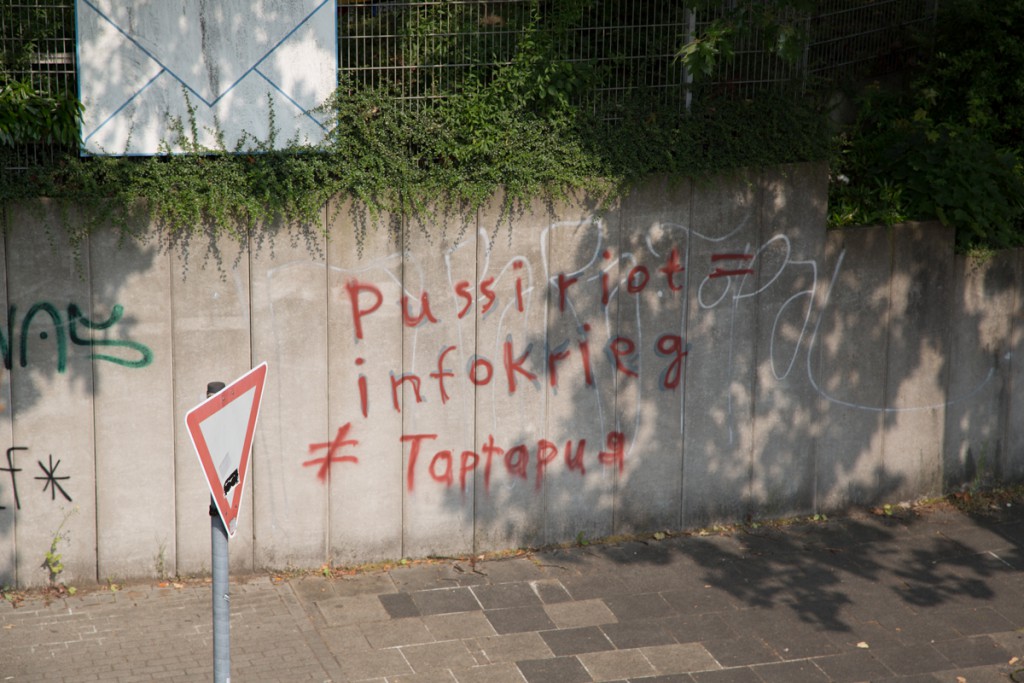
Photo 06: View from the pedestrian bridge.
Day 3, Wednesday 24 July
Exploration
A middle-class residential district behind the Altstadt with turn-of-the-century buildings. The atmosphere was noteworthy and memorable because of the weather: light rain, very humid, with a constant rumbling of thunder in the distance. We walked through the Alter Friedhof cemetery and the adjoining park. We then proceeded to the Wasserbahnhof, the landing stages for the ships touring the Ruhr river.
Recordings
1. Wasserbahnhof: tour boat before departure.
2. Piezo recording on the metal link of the big bridge, rhythmic clattering sound caused by the wheels of the passing cars.
Photo 07 & Audio 05: Clattering of wheels on Schloßbrücke.
Intervention/installation
1. Synthesised electronic sounds with music-box–like melodies were installed in a house entrance situated between a gaming salon and an orthopaedics shop, four-channel installation with higher and lower pitched sound.
Audio 06: Music box high.
Video 02: Installation in house entrance between a gaming salon and an orthopaedics shop’s window.
Effect/observations: In this small cave-like space with considerable resonance, the sounds transformed the sober atmosphere of the space (to a more ‘mysterious’, ‘unreal’ atmosphere – appropriate words are difficult to find). The installation matched the architectural structure of this transitional space: whereas the sounds were barely audible from outside, inside the sound dominated perception of the space.
This is an example of how, because of the way in which sound fills the space, by adding sound the perceived qualities and characteristics and thereby the atmosphere of a space is transformed. Max Neuhaus describes how sound changes the perception of scale: ‘In these imaginary places that I build, often the moment the listener first walks into the space, it is not clear that a sound is there. But as you begin to focus, a shift of scale happens. At first you hear what could almost be a room sound, which then suddenly becomes huge. As you enter into it, you move into another perception of space because of the change of scale’ (Neuhaus 1994: 97). In another of my own works I experienced how a sound work shapes and forms the space. In open spaces that are not shaped by architecture – by bordering walls and buildings – sound can form the space so that it is perceived as an integral unit. (Example: in Vexierklang Hardenstein the loudspeakers surrounding the castle ruins marked and shaped the acoustic space. – weblink) Also, visitors often remarked on the beauty of an installation’s location. This concerns the choice of site for the work, which is of course already part of the artistic process; but it is the transformation of the ambience through composed sound that can turn a site into a space with coherent characteristics, making it appear ‘beautiful’.
2. Reinstalling of subway escalator sounds next to the escalator itself.
Reinstalling existing sound at a site is a form of doubling, a sonic reflection, like the reflection of an image on a mirroring water surface. The word reflection points to the process of becoming aware, conscious, cognisant of something. A doubled sound image is never the same sound, there are differences – the doubled sound is emitted through speakers, it is usually softer, often spatially more directional, etc.
The irritated looks on the faces of the passers-by showed that they noticed the sound. What this irritation actually means, what aesthetic potential it has, is something that can be discussed and explored in further artistic research.

Photo 08: Reinstaling escalator-sounds at the escalator.
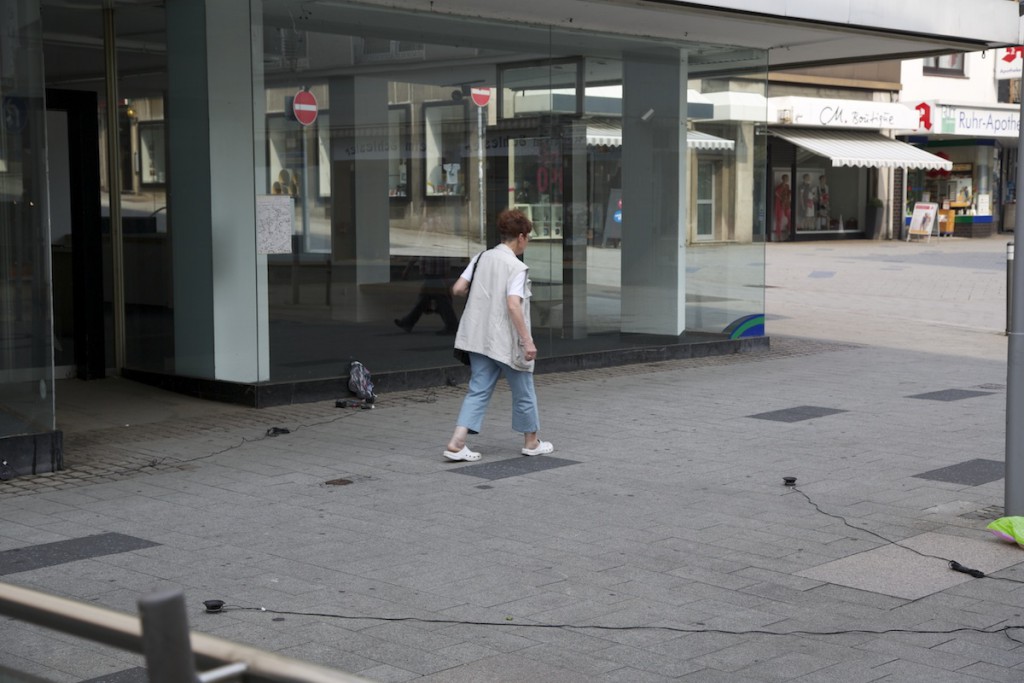
Photo 09: Reinstaling escalator-sounds around the escalator.
Video 03: Re-installation of subway sounds at Stadtmitte subway station.
3. Water sounds from recordings of the nearby water fountains and synthesised electronic sound were installed on a street light pole on Schloßstraße. The two speakers were attached vertically down the lamp pole. The sound was soft, but noticeable, people stopped to listen to the sounds from close-up. With the sound bearing a slightly strange electronic twist (we called it ‘spooky’), the transformation effect could again be observed. As evening fell, the time of day (shops closing, a hint of dusk, less activity on the street) reinforced this effect.
Audio 08: Spooky atmospheric sound.
In these summer days, we experienced the ambience and vibe of Schloßstraße – which generally would be regarded as a very average if not ugly shopping pedestrian street, typical of countless smaller German cities – as remarkably relaxed: retired people having coffee in the middle of the street at the tables of the cafés, small children playing at the fountains, groups of older immigrant kids playing with a soccer ball – the atmosphere resembled that of a relaxed holiday town. One women remarked that the music of the installation gave her ‘gute Laune’ (a good mood) and made her think of holidays in an Italian town, where she would also listen to music. During this installation we also met an art historian living in Mülheim, who we remained in contact with and who later visited other events within the project.
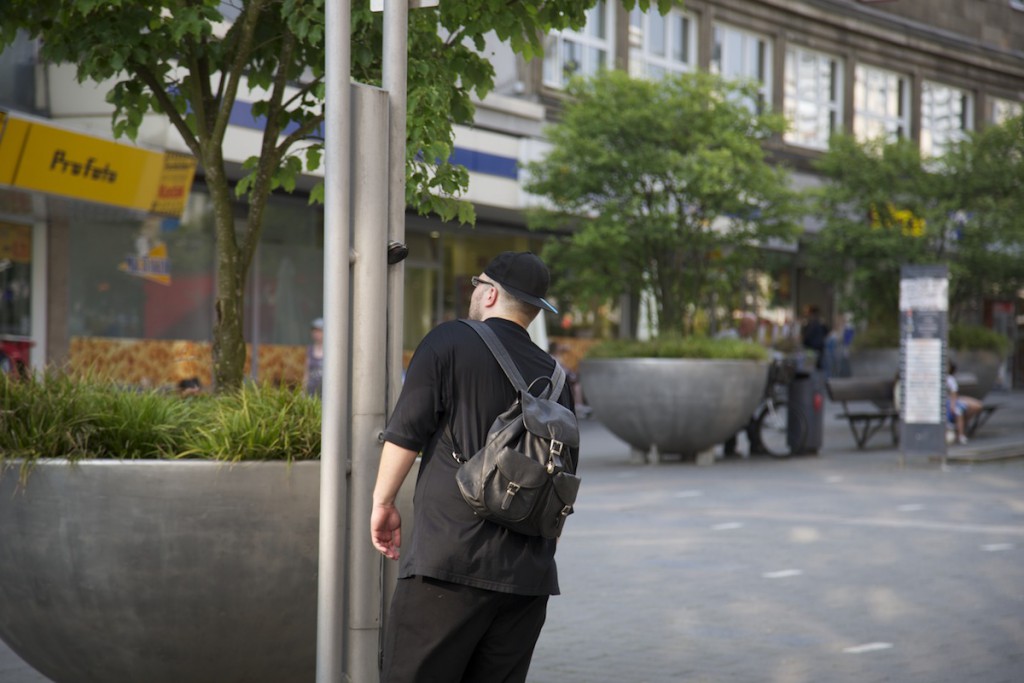
Photo 10: Nearby water fountains and synthesised electronic sound were installed on a street light pole on Schloßstraße.
Day 4, Thursday 25 July
Exploration
Broich, another middle-class residential area on the other side of the Ruhr.
Recordings
1. Chewing gum automat on the street reminding us of our childhood in the 1970s …
2. Children bathing in a paddling pool in an area of lower-middle-class modernistic housing blocks from the sixties.
Audio 09: The suburb of Broich. (Surround audio recording, best listened to through headphones.)
3. Birds in a small patch of trees amid the housing blocks.
4. Broich subway, with the specific sound characteristics of the escalators as in the previously recorded subway escalator sounds in the inner city.
Interventions/installations
1. A four-channel installation at the Stadtmitte bus stop at the end of the pedestrian Schloßstraße; a very busy road/intersection and one of the main bus stops in Mülheim, where buses arrive every few minutes: four speakers were placed on a ledge, playing mainly the ‘music box’ atmosphere, we also tested the metal bridge clattering. The ledge was the windowsill of the shut down department store (Kaufhof). This site tells you much about Mülheim and developments in the city centre: the department store, typically situated in the city centre, is now unused, and has a forlorn vibe about it.

Photo 11: Installation on the ledge near the central tram-stop.
In their project City Telling Ruhr: Stadt als Erzählung, Erinnerung und Idee, also within the Mülheim research lab of ZHdK, Tobias Gerber and Ingo Starz conducted interviews with Mülheimers, many of whom mentioned the Kaufhof and expressed regret that the department store had shut down and the site was unused.
Coincidence: above the ledge where we placed the speakers, there was the same tag, ECHO, which was also written on the wall where we placed our installation on the Helmut Schlitt bridge (see day 2).
Coincidences seem to happen so regularly when working in public space that I have come to call this phenomenon ‘structural coincidence’ – reality manifests itself in so many layers, that there will always be some kind of overlay (Reese 2012: 32).
The sound of the installation was very quiet, barely noticeable. Jan and I discussed what it means if an artist creates an intervention or installation ‘at the threshold of perception’.
Max Neuhaus (1994: 64): ‘The public works are all deliberately pitched at a threshold of perception, a point where people can notice them or not notice them. They’re often disguised, almost hidden in their environment.’ Is it a radical position from the artist’s point of view because it is not utilitarian, or is it elitist? The installation here seemed to give more of an indication of what people do at this particular spot in the city, and how the space itself functions, rather than having an aesthetic impact. The temporal dimension of installations in open space – even if they are permanent or long running and have slowly evolving or constantly repeating sound material – became obvious here, at this very busy location at this particular time of the day. The sounds may remain the same, but the soundscape around them changes according to the structure of activities at the site, which itself changes according to certain rhythms – day and night (bus schedule!), weekday or weekend, weather, season.
2. A two-channel installation in trees in plant pots along Schloßstraße: the intention was to experiment with text/spoken words. The sound material consisted of a short newspaper clipping about the reduction of butterfly species. At first the passers-by were hardly aware of the sound. When we optimised the set-up, more people were attracted to the sound.
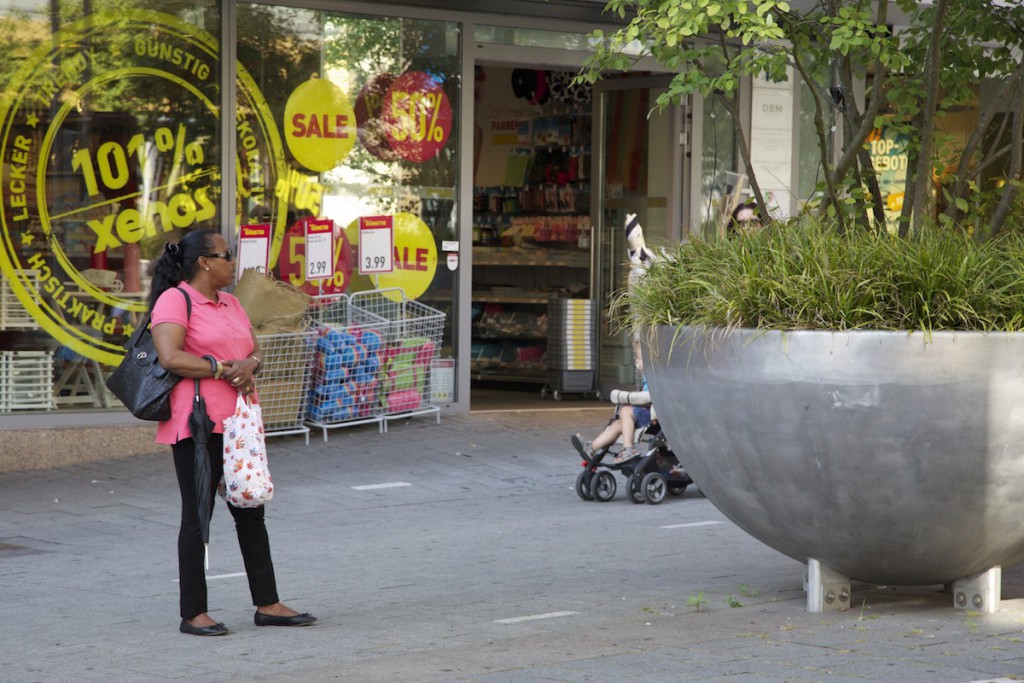
Photo 13: Installation in a tree.
The audibility could be influenced and affected by manipulating the following parameters:
– Position and direction of the speakers
– Volume of sound tracks on the player in relation to the performance of the speakers (as loud as possible, but not so loud as to make the small speakers distort)
– Closeness to the audience in relation to the route they took along the street; for example when we selected a plant pot from which the distance to the next building was a bit smaller, this made people walk past a bit closer, and even a small change makes a difference with regard to the noticeability of the sound
– Sonic density created by adjusting the position of the speakers, placing them closer to one another
– Density of the sound on the tracks
– If applicable, acoustic reflections at the locationAs the loudspeakers were placed in the trees, they were somewhat camouflaged. One could observe how the passers-by first became aware of the sound, usually indicated by an irritated look on their faces, then they started looking for the sound source.
3. Installation with four speakers on the ground surrounding a fixed metal chair in the pedestrian area of Eppinghofer Straße: again the installation was very soft, but it was possible to adjust the volumes and positions of speakers so that they had the appropriate amplitude for someone sitting on the chair.
Effect/observation: Being surrounded by sound, the person sitting will feel withdrawn from the reality of the site and observe what is going on – the continuous passing by of people (‘ant trail’) – as if it were taking place on a stage, resulting in a shift and transformation of reality.
Video 04: Four speakers on the ground next to a chair in the pedestrian zone.
In general, because of their small size the loudspeaker chassis used are never loud, and can’t project over a greater distance, especially in the ambiance of a noisy city. The size of the speakers, on the other hand, makes them adaptable to the hearing situation in relation to the distance between the human ears. If the speakers are placed in a triangle with proportioned distances regarding the head/ears, pronounced panning and spatial effects are possible.
4. Installation of two speakers in the grid of the parking garage at Eppinghofer Straße, with the sound of the ‘music-box’ atmosphere. The sound from the speakers mixed with pop music that emanated from the parking garage in a way that meant it was hardly noticeable and distinguishable at first, creating a spatial depth with foreground and background. Two children interacted with the speakers (by touching them) and engaged in a conversation with us.
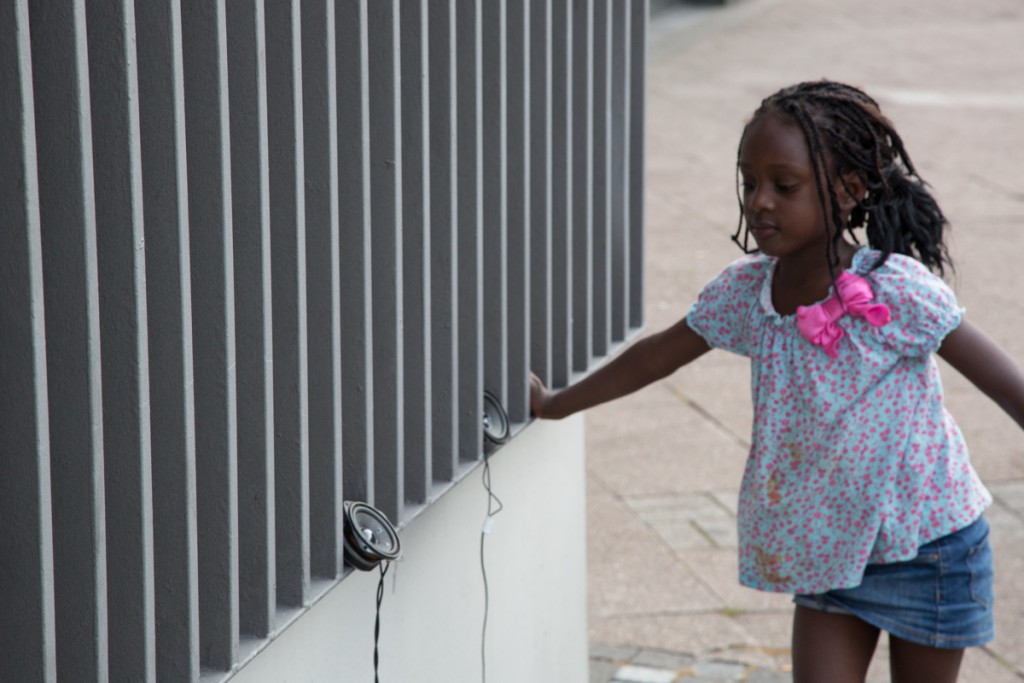
Photo 14: Parking garage installation with curious visitor.
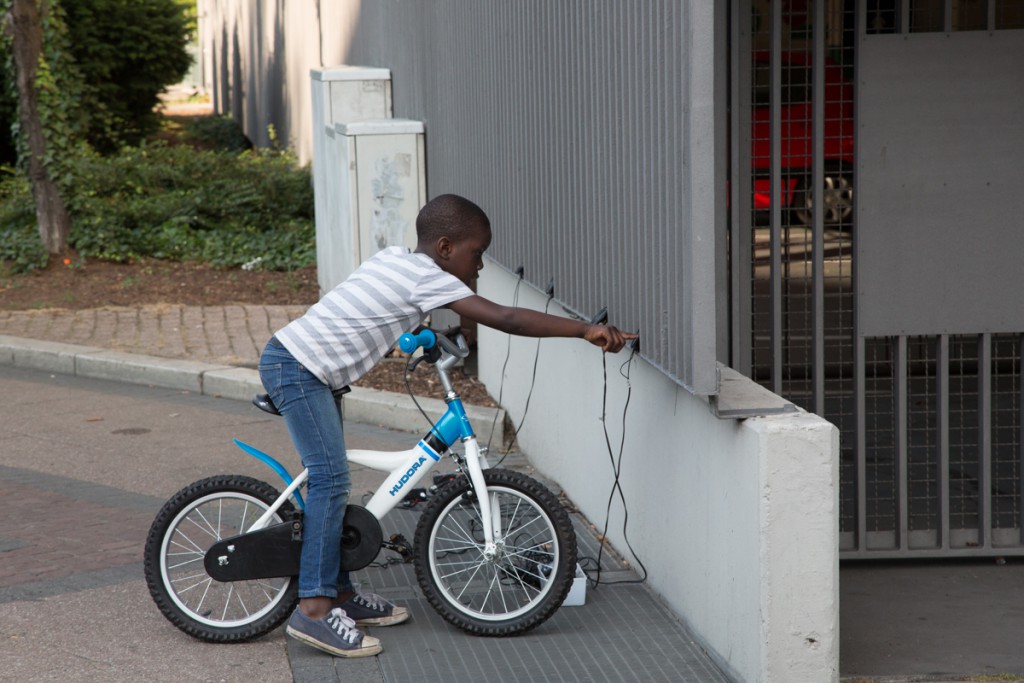
Photo 15: Parking garage installation with another curious visitor.
Day 5, Friday 26 July
Intervention/installation
1. Installation at the same chair as the day before, this time with a self-made plastic structure with two speakers attached that was directly aimed at the ears.
Video 05: Speaker installation aimed at the ears.
Several sound materials were tested: the bridge clattering resulted in a kind of neutral perception study and in the listening room the clattering positioned itself around the ears and the head in a 3-D, geometrical way.
Effect/observations: Again there were two distinct outside/inside perspectives: from the outside the sound was barely noticeable, but inside it was very present and spatially differentiated. Because of the colourful plastic construction, the situation was visually striking and was noticed by passers-by.
Although visually much more obvious than was the case with the lamp post, this situation was slightly off-center; thus, it was further from where pedestrians pass by and seemed to be self-contained – people did not seem to feel invited to approach and examine the loudspeakers and the situation, as they had with the lamp posts. Only one man sat down to listen. He associated the ‘spooky’ ambient sound with other music (‘sounds like R.E.M.’), and the listening situation of a home surround system. In addition, the owner of one of the nearby coffee shops approached us, fearing that his costumers might potentially feel bothered by us taking photos – another take on the question of the invasiveness of artistic interventions in public space. The art historian we met the other day at the lamp-post intervention came by again; she thought the listening situation was ‘very pleasant’.
